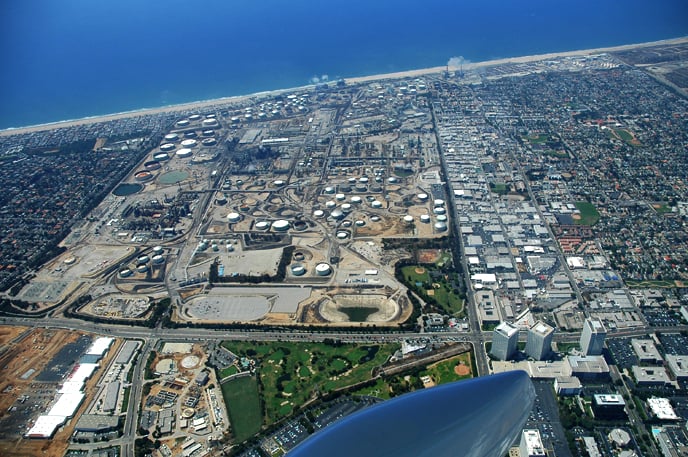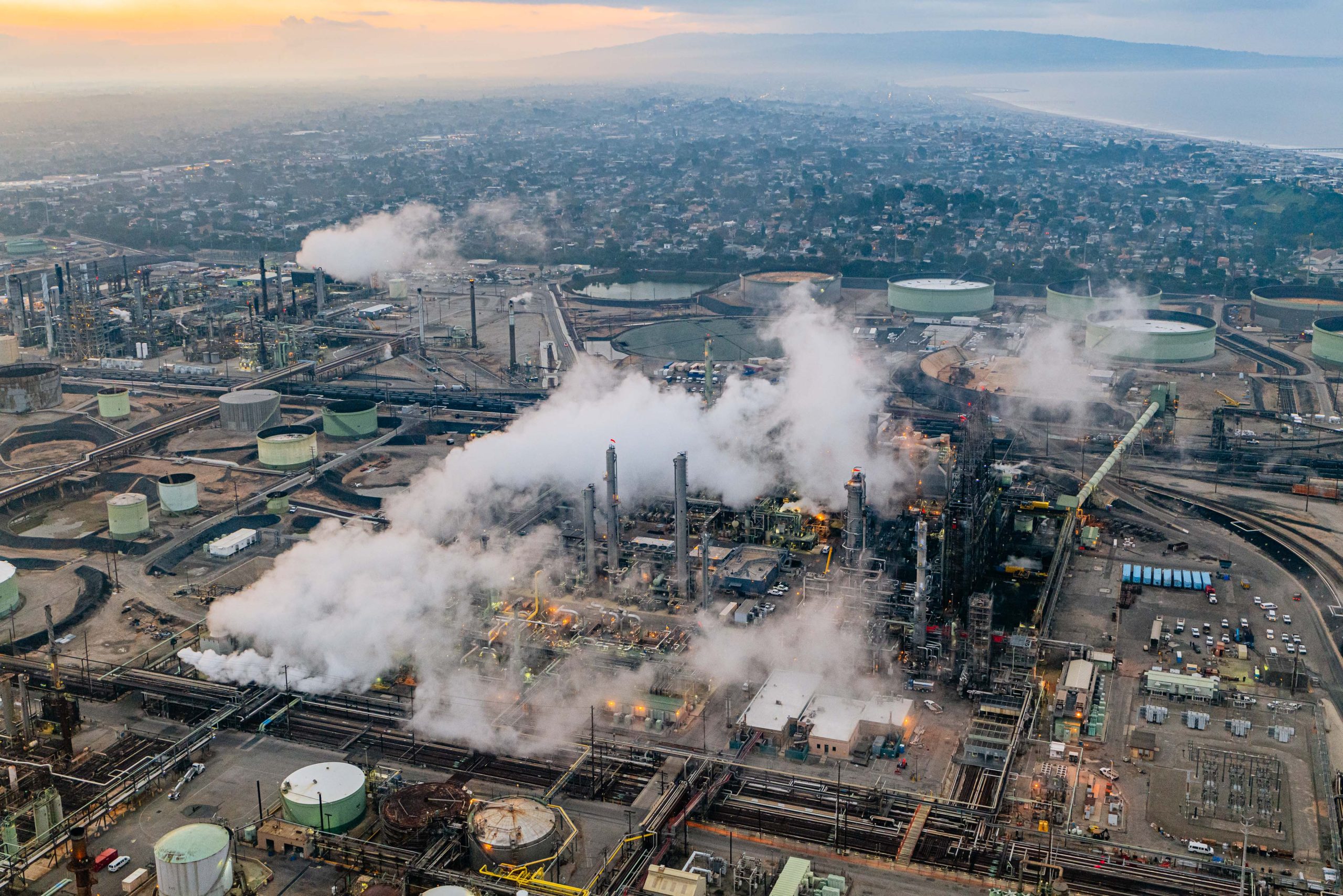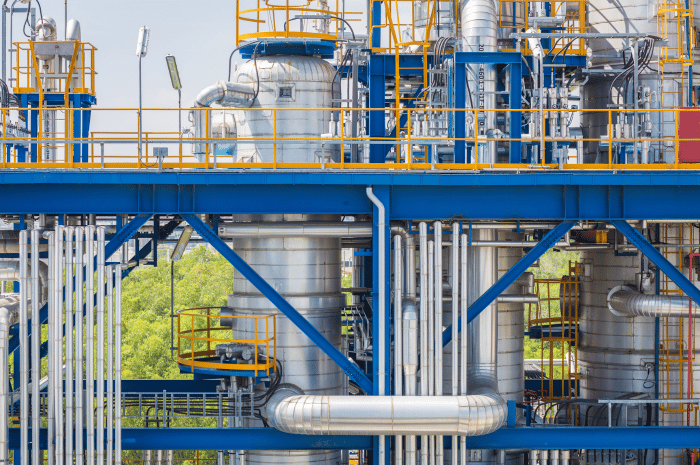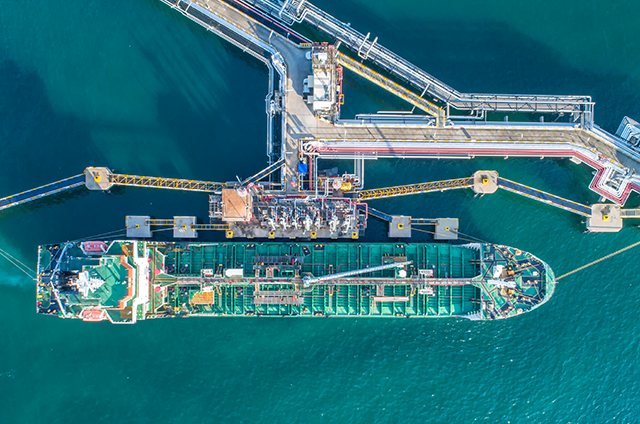
Chevron El Segundo Refinery, Broader Aerial Facility View | Credit: MIT Club of Southern California
Overview
The Chevron El Segundo Refinery is one of California's largest and most strategically important petroleum refining facilities, operating continuously since 1911. Located approximately 19 miles southwest of downtown Los Angeles and adjacent to Los Angeles International Airport (LAX), the refinery serves as a critical component of California's energy infrastructure.
Historical Development
Early History (1911-1984)
- 1911-1912: Constructed by Standard Oil Company of California during the trust breakup period
(original capacity was 5,000 barrels per day (BPD) of crude and the main product was kerosene for lamps)
- 1931: Introduction of Chevron brand designation on products
- 1977: Continued operation under Standard Oil of California (Socal)
Modern Era (1984-Present)
- 1984-1985: Company renamed to Chevron Corporation following Gulf Oil merger
- 2001: Became part of ChevronTexaco following merger
- 2005: Returned to Chevron Corporation name after Unocal acquisition
Processing Capacity & Storage Infrastructure
The refinery, with a two-square-mile facility footprint, has a rated crude oil processing capacity of 290,000 barrels per day (bpd), making it the second-largest refinery in California and Chevron's largest facility on the West Coast. Typical operating capacity stands at 280,000 bpd.

Chevron El Segundo Refinery, California Aerial Photography | Credit: Tobby Harriman - Apr 17, 2024
Feedstock Supply:
- 20% via pipeline from California sources
- 80% via marine terminal
The facility supplies approximately:
- 20% of all motor vehicle fuels in Southern California
- 40% of the jet fuel consumed in the region
- Critical fuel supplies for Los Angeles International Airport (LAX)
The refinery boasts extensive storage capabilities with:
- Total storage capacity of 12.5 million barrels
- Approximately 150 large storage tanks greeter than 30 feet in diameter across the facility
- The largest tank holds about 540,000 barrels
- Tank 1015 is one of the largest, with a diameter of 260 feet and a height of 64 feet
Refinery Configuration
The El Segundo refinery operates 34 key processing units and operations, representing a comprehensive petroleum refining complex. Major processing units include:
Primary Processing Units
- Crude Distillation Units: No. 2 Crude Unit (2CU) and No. 4 Crude Unit (4CU) for initial crude oil separation
- Stripper Unit: No. 2 Residuum Stripper Unit (RSU
- Vacuum Distillation: Part of the No. 4 Crude Unit for processing atmospheric residuum
- Delayed Coking Unit: 75,000 bpd (upgraded from 60,000 bpd)
Catalytic Processing Units
- Fluid Catalytic Cracking (FCC) Unit: 73,000 bpd capacity for converting gas oils to gasoline and lighter products
- Hydrocracking Unit: Isomax 7 unit (the one affected by the October 2025 fire)
- Continuous Catalytic Reformer (CCR): 60,000 bpd capacity for gasoline octane enhancement
- Alkylation Unit: Combines light olefins with isobutane using sulfuric acid catalyst
- Penex Isomerization Unit: For gasoline octane improvement
Hydrotreating and Specialty Units
- Vacuum Residuum Desulfurization Unit (VRDS)
- Minalk/Merox Unit
- VGO (Vacuum Gas Oil) Hydrotreater: Upgraded in 2006 for ultra-low sulfur diesel production
- Naphtha Hydrotreaters: Multiple units (NHT-1, NHT-3) for gasoline desulfurization
- Jet Hydrofinishing Plant (JHP): Produces low aromatic blendstock for jet and diesel fuel
Support and Utility Systems
- Hydrogen Production: Steam Naphtha Reformer (SNR) and Steam Methane Reformer (SMR) plants
- Sulfur Recovery Units: Multiple H2S plants (No. 5 and No. 6) for sulfur removal
- Cogeneration Facility: providing electricity and steam to the refinery
Product Portfolio
The refinery produces a comprehensive range of petroleum products:
Primary Products
- Motor Gasoline: 45% - Multiple grades including CARB Phase 3 compliant formulations
- Jet Fuel: 41% together with diesel - Major supplier to LAX and regional aviation market
- Diesel Fuel: 41% together with jet fuel - Ultra-low sulfur diesel meeting California specifications
- Petroleum Coke: 10% together with fuel oil - Approximately 4,460 tons per day exported through Ports of Los Angeles and Long Beach
Specialty Products
- Sulfur: Recovered from hydrogen sulfide removal processes
- Petroleum Gases: LPG (4%) and fuel gas for internal and external use
- Alkylate: High-octane gasoline blending component
Recent Operational Challenges
2025 Fire Incident
On October 2, 2025, a major explosion and fire occurred at the Isomax 7 unit, creating 300-foot flames visible for miles and requiring extensive emergency response. The incident highlighted ongoing safety challenges at the facility, which has accumulated:
- 46 violations from the South Coast Air Quality Management District over five years
- 13 violations in 2024 alone
Regulatory Compliance
The refinery has undergone multiple environmental upgrades to meet California's stringent fuel specifications, including:
- CARB Phase 3 Clean Fuels Project (2001) for reformulated gasoline production
- Heavy Crude Project (2006) enabling processing of heavier crude oils
- Ultra-Low Sulfur Diesel capabilities meeting 15 ppmw sulfur requirements
Strategic Importance
The El Segundo refinery plays a critical role in California's energy security, particularly given the state's isolated fuel market and limited refining capacity. Its proximity to LAX makes it essential for West Coast aviation fuel supply, while its substantial motor fuel production capacity serves the broader Southern California market. The facility's continued operation is vital for regional energy independence and price stability in one of the nation's largest fuel consumption markets.


















